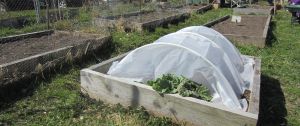This weekend, I made it out to the orientation for one of Burlington’s community gardens. We lucked out with some gorgeous, sunny weather that encouraged me and many others to stick around for a while and begin weeding and loosening up the soil for some spring planting.
 While most of the adults began hoeing and digging and planting a few seeds, five or six children played around in the garden or by the playhouse. One young girl crouched down by a garden bed and grabbed some soil in her hands. While I didn’t catch on to the possibility that she might try to eat the soil, one of the adults must have sensed this because she told the young girl, “Don’t eat that [soil]. That’s not food dirt. The only good food dirt is crumbled-up Oreo cookies.”
While most of the adults began hoeing and digging and planting a few seeds, five or six children played around in the garden or by the playhouse. One young girl crouched down by a garden bed and grabbed some soil in her hands. While I didn’t catch on to the possibility that she might try to eat the soil, one of the adults must have sensed this because she told the young girl, “Don’t eat that [soil]. That’s not food dirt. The only good food dirt is crumbled-up Oreo cookies.”
Now, I understand the message this woman was trying to get across to the little girl, which was: soil is not food. Beyond this, the woman may have been considering health risks associated with consuming contaminated dirt. After all, this garden site might be made up entirely of raised garden beds because of known soil toxicity.
In any case, I was really interested in this woman’s way of explaining safe and unsafe food. Translation: don’t eat soil (unsafe), but do eat Oreos (safe)!
Shucks, I’m thinking of those trendy health books with titles like, “Eat This, Not That” where the calorie counts of foods are compared, but here’s how it would look with those Oreos:
I know we want to prevent the girl from eating soil, but might there have been a better way to explain this than the promotion of junk snack foods?
While this one little transaction probably won’t change the girl’s eating habits, could repeated exposure to similar situations result in her associating soil with unsafe or contaminated food, and associating the more processed, “clean” foods with safety? (see my previous post commenting on sociologist Lupton’s theories about food hygiene)
Many people (maybe you?) freak out when they see little bugs crawling on a head of romaine lettuce. Sure, it might be a little bit gross, but my first thought when I see a few aephids on my lettuce is, “Yay – this food really might have been grown organically!” I’m not proposing we all go out to our yards and begin nibbling on bits of dirt and bugs, but I do get concerned that the way we approach this topic might teach children to be cautious of eating things that come from the ground… especially when the safe, crumbly dark stuff we could have instead is a few Oreo cookies.
We don’t want kids to get sick by eating dirt, but we also don’t want them to be afraid of soil and all things that come from it… mistakenly thinking that processed, packaged foods are ‘safer’ and therefore the better food choice.
FN 3/16

I completely agree with you – why that would be her choice of explanation I’m not sure. Perhaps she was just taken off guard and it was the first thing that came to mind?
I think you’re right that the Oreo example was simply the first idea that came to mind. My concern is just that, actually: the first thing the woman defaulted to was a commercial snack food… and this little girl is probably already inundated with that kind of food marketing. Maybe the adult chose this analogy because the social expectation is that kids are supposed to know and eat Oreos.